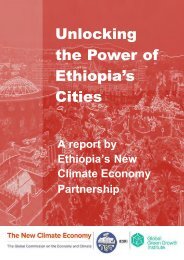EY-africa-attractiveness-survey-june-2015-final
EY-africa-attractiveness-survey-june-2015-final
EY-africa-attractiveness-survey-june-2015-final
Create successful ePaper yourself
Turn your PDF publications into a flip-book with our unique Google optimized e-Paper software.
www.ey.com/<strong>attractiveness</strong>Renewable Energy Independent Power ProducerProcurement ProgramAfrica50 aims to mobilize privatefinancing in order to acceleratethe speed of infrastructuredelivery in Africa. It will focuson transformational nationaland regional projects in energy,transport, ICT, and water. It iscomplementary to, but legallyindependent from, the bank.It is not business as usual. Thekey objective is to create viable,bankable projects (shortening thetime between project idea andfinancial close) from a currentaverage of seven years, to lessthan three years. This will delivera critical mass of infrastructure inAfrica in the short to medium term.Among other things, this entailssubstantially increased funding ofearly-stage project developmentactivities and making skilled legal,technical and financial expertsavailable to projects from an earlystage of development.Although these initiatives do notprovide all the answers, it will makea real difference in addressing theinfrastructure deficit, and is oneway that we can make sure ourchildren and grandchildren do notinherit our burden.Case studyIn recent years, South Africa has become a global leader in facilitatingsustainable private investment in the renewable energy sector. After almosta decade of deliberating on renewable energy policy, the South AfricanGovernment made a decisive move in May 2011, initiating a process to procurea total of almost 7,000MW of renewable energy projects from the private sectorvia competitive bidding over multiple bid windows. There was initially muchskepticism as to whether South Africa could deliver on the ambitious time linesand targets that were set.In fact, the Renewable Energy Independent Power Producer ProcurementProgram (REIPPPP) has exceeded expectations, and become a model forsuccessful partnership between the public and private sectors. To date, 79projects have been awarded to the private sector, with the first projects alreadyon line. Private sector investment, totaling approximately US$16b, has beencommitted so far to projects that will generate about 5,240MW (which equalsapproximately 12% of the current installed capacity of Eskom, South Africa’sgovernment-owned power utility.) This includes investment in grid-connectedonshore wind, photovoltaic and concentrated solar power, as well as small hydro,landfill gas and biomass generating plants.Besides the obvious contribution to an energy-constrained economy, theREIPPPP has helped create approximately 27,000 person-years of constructionwork and about 55,000 person-years of operations work, over the 20-yearlife of the projects, in a country where jobs are badly needed. Additionally,significant reductions in tariffs were achieved: the average fully indexed pricefor photovoltaic solar power for preferred bidders in the fourth bid round inApril 2014 terms is R7.86/kWh, 76% lower than the inflation adjusted averagetariff for preferred bidders in the first bid round in November 2011. Similarly,the average fully indexed price for onshore wind-generated electricity in April2014 terms for preferred bidders in the fourth bid round is R6.19/kWh, whichis 55% lower than the inflation-adjusted tariff achieved in the first bid round inNovember 2011.Given the broader power deficit across Africa, the REIPPPP is an importantexample of what is possible if we harness our natural resources via effectivecollaboration between the public and private sectors. According to theInternational Energy Agency’s latest Africa Energy Outlook report, Africancountries are endowed with such abundant renewable energy potential thatrenewables could make up more than 40% of SSA’s power generation capacityby 2040.This case study is based on a compilation of publicly available information, written by BrunhildeBarnard, Africa Advisory Infrastructure Leader, <strong>EY</strong> Africa.<strong>EY</strong>’s <strong>attractiveness</strong> <strong>survey</strong> Africa <strong>2015</strong> Making choices51



